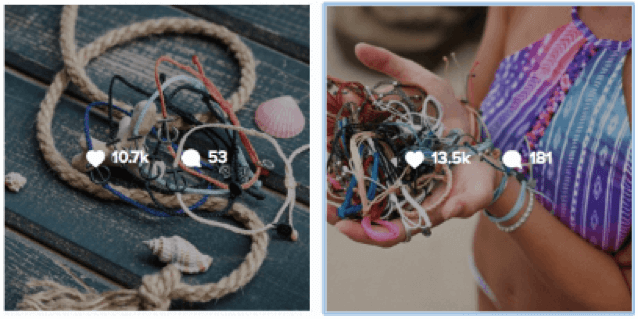In today’s social media-driven world, the phrase “social media influencer” is becoming the golden standard. However, the secret sauce behind influencer marketing strategies with micro-influencers can be challenging to get a hold of. Nonetheless, brands and digital marketers are catching onto the importance of more strategic and cost-effective influencer marketing strategies — micro-influencers.
Influencer marketing, the process of using social media influencers for branded and paid content creation, is known to be an approachable and affordable marketing strategy. According to a recent Influencer Marketing Hub report, more than 50 million people around the world see themselves as social content creators, contributing to the rise of social commerce, which is predicted to account for 17% of eCommerce by 2025.
With so many social media content creators and a majority of consumers spending time on social media regularly, brands are looking to micro-influencers and user-generated content (UGC) to improve reach and drive lasting brand engagement. At the same time, brands and marketers are also seeing a rise in user-generated content (UGC) on social media, reviews, testimonials, and more.
It’s no coincidence that as social media influencers continue to rise, the creation and value of customers’ UGC is also growing. Let’s take a closer look at the benefits of using micro-influencers over influencers and celebrities, their impact on UGC, and potential marketing strategies you can use.
What are micro-influencers?
According to Forbes, micro-influencers are social media users who have 10,000 – 50,000 followers. However, this number is still up for debate as many, for instance, Harvard Media considers micro-influencers to have 5,000 to 10,000 followers. Macro-influencers can have follower counts ranging from 50,000 to 1 million. Once an individual reaches 1 million followers, they are classified as a celebrity influencer.
However, the allure brands see for leveraging influencers comes with many stipulations. Advertising with celebrity influencers tends to require complex contracts, high-costs, and doesn’t always signal an increase in engagement. Rather macro-influencer and celebrity influencer marketing are better suited for brand awareness and rebranding, in the instance of negative sentiment or acquisition.
This is where micro-influencers win. Micro-influencers’ smaller and more approachable follower count comes with increased engagement, lower costs for brands, and a higher return on investment. This is due to micro-influencers ability to engage with their audience in comments, stories, direct messages, and more niche interests, cultivating a deeper level of emotional connection between the micro-influencer and their followers.
What is an influencer marketing strategy?
Influencer marketing lives on social media channels such as Instagram, TikTok, Youtube, Facebook, Twitter, and more. While each of these platforms can help your brand grow, it’s important to consider where your target audience and ideal customers spend their time. Are they scrolling through Instagram, are they watching and creating content on TikTok, or are they spending time streaming videos on Youtube? Knowing where your audiences are most present is the first step in creating an effective influencer marketing strategy.
More specifically, an influencer marketing strategy is a type of social media marketing that relies on product mentions, endorsements, and promotions provided by one or multiple influencers (personal social media accounts). Later we will touch on creating an influencer marketing strategy, but first, here are the most notable benefits of micro-influencer marketing.
What are the benefits of micro-influencer marketing?
1. Helps with cost efficiency
According to Influencer Marketing Hub, micro-influencers tend to charge anywhere between $100 to $500 per post. This number jumps drastically when brands leverage influencers, who may charge anywhere from $10,000 up to $1 million per post (the higher end being household celebrity names). Because micro-influencers have generally higher engagement rates — 3.86% on Instagram compared to 1.64% for celebrity influencers — brands can see a bigger return on their overall digital marketing spend.
2. Creates and fosters community and engagement
Aside from the cost, engagement is key when choosing which influencer, micro or otherwise, to work with. Engagement rates are defined as the calculation of an audience’s involvement with an influencer’s content. This includes, but isn’t limited to followers, story and post reshares, comments on posts, likes on posts, etc. All of these factors are considered when measuring an influencer’s engagement rate. Micro-influencers tend to have higher engagement rates than other influencer types.
Their comparatively smaller follower count and somewhat niche audiences allow micro-influencers to foster more interactions and authentic engagement with their followers. According to Statista, micro-influencers with approximately 5,000 followers had the highest engagement rate at 5%. This is much higher than the average macro and celebrity level influencer engagement rate of 2.2%.

Pura Vida bracelets using influencers on social media
3. Boosts UGC and empowers customers
Similar to the concept applied to engagement rates, micro-influencers’ ability to connect with audiences on a more granular and intimate level empowers customers to share UGC and visual user-generated content (VUGC).
For example, suppose an Instagram user with 800 followers sees that one of their favorite micro-influencers, with around 9,000 followers, is sharing content about a brand they have also purchased from. In that case, audiences will tend to feel more empowered to also share their experience with that brand or brand’s product. This is largely due to the psychology behind influencer marketing, which Forbes describes as the emotional connection that sharing personal photos and videos “gives audiences a look into the true life of influencers, which can make followers feel personally connected.”
4. Cultivates organic traffic and drives brand loyalty
Micro-influencers also tend to generate larger volumes of organic traffic and drive brand loyalty. According to a Business Wire report, 61% of social media users are more likely to trust a brand recommended by a friend or influencer on social media, compared to only 38% from ads generated by brands themselves. When we think about how brand trust affects brand loyalty, we can consider the two closely linked. Our 2022 State of Brand Loyalty Survey pointed out that consumers associate trust with brand loyalty above any other word.
How to create a micro-influencer marketing strategy
Here are five steps to consider when creating and managing an impactful micro-influencer marketing strategy:
1. Set benchmarks and goals
A key differentiator in successful micro-influencer marketing campaigns is discovering the right micro-influencer. Homing in on your brand’s target audience, including your customers’ potential niche interests, plays a huge role in effectiveness and engagement. However, before reaching out to specific micro-influencers, it’s important to set benchmarks and goals that measure the success of your micro-influencer marketing campaigns.
One brand that set up successful goals and benchmarks for their micro-influencer marketing strategy and UGC strategy is Princess Polly. Specifically, because Princess Polly is a global clothing brand, they have different marketing goals for different geographies. The Australian brand is focused more on acquisition in the US and other countries, requiring them to create campaigns different than their Australian marketing plans. By differentiating this early on, Princess Polly leverages micro-influencer marketing on social alongside successful UGC-driven marketing strategies.
2. Research your audience and potential strategies
Similarly, while brands tend to have a general target audience, customers within a brand’s target audience will have varying interests based on segmentation (e.g., age, location, purchase history, etc.). Where influencer and celebrity endorsements fall short — possible overgeneralization of a brand’s audience’s interests — micro-influencer marketing makes up for it by promoting your brand to niche audiences, which might be better suited for some customers.
One way to research potential micro-influencers is by leveraging existing UGC. For example, your brand can look at its “tagged” page on Instagram and see if any micro-influencers are already posting about your brand. Or, if you haven’t quite found the right prospects on your brand’s social media pages, exploring and analyzing existing customer data — like UGC, VUGC, and reviews — can narrow down potential unique interests that span across multiple segments in your target audience.

3. Connect with micro-influencers and establish logistics
Once you’ve found potential micro-influencers to reach out to, it’s important to set budgets and timelines, and consider other logistical components before reaching out to them. That way, when you do successfully connect with a micro-influencer(s), all of the documentation is in place to get started right away. Some logistical components to consider include:
- Brand mission
- Budget
- Timeline
- Content format
- Usage rights
- On-brand messaging
- Engagement goals
Establishing logistics also allows you to have a transparent conversation with prospects so you can focus on making sure they match your brand’s mission and engagement style. Some things to consider in these initial conversations include:
4. Report and assess campaign progress
After executing a post or campaign with a micro-influencer, it’s important to track and measure the success of their content. Brands can do this by offering trackable discount codes micro-influencers can use in sponsored content, by giving UTM links to track what account on-site traffic is coming from, or by measuring the engagement on a particular branded post. It’s also important to assess the engagement and effort your micro-influencers are putting into the content they create — lack-luster content will generate lack-luster engagement.
Relatedly, it’s important to give micro-influencers multiple opportunities to post and support multiple posts over time. This fosters more organic engagement and appears more authentic to audiences. Whereas, a random sponsored post with no follow-up might appear out of place.
5. Stay engaged with your influencers and create connected marketing
Likewise, it’s important to stay in contact with micro-influencers and make sure they feel like they are positively impacting your brand’s mission. Collaboration is key, as no one knows your audience better than the micro-influencers interacting with them on a daily basis. Brands like Pura Vida, have found success in influencer marketing by working closely with their influencers, to make sure they feel like a part of the process.
In addition to staying in touch with micro-influencers, your marketing strategy should include dedicated time and budgets that can account for unforeseen trends or seasonal content. This helps your brand stay fresh and relevant.
Being active in your marketing strategy and connecting your social strategy with your digital strategy can also help increase your reach, foster community engagement, and strengthen brand loyalty. This can look like reposting UGC onto your brand’s social media account or featuring micro-influencers in on-site content.
The future of micro-influencers: Leveraging alternative channels
With micro-influencers, word-of-mouth marketing can exist successfully in a digital space. As we approach an increasing online landscape, with notable micro-influencer success being seen on social media channels like TikTok, it’s more important than ever for brands to leverage micro-influencer marketing.
Beyond increasing organic traffic to your site and promoting new releases and campaigns more cost-effectively, micro-influencers empower “typical” customers to share branded content via UGC and VUGC. This concept suggests that brands seeing growth in their UGC are creating an ecosystem of micro-micro-influencers without even knowing it.
Micro-influencers FAQs
How do micro-influencers differ from macro-influencers and celebrity influencers?
Micro-influencers are social media users with a follower count ranging from 5,000 to 50,000. They have a relatively smaller audience compared to macro-influencers, who typically have follower counts between 50,000 and 1 million, and celebrity influencers, who have 1 million or more followers.
How does the engagement rate of micro-influencers compare to other types of influencers?
Micro-influencers tend to have higher engagement rates compared to other types of influencers, such as macro-influencers and celebrity influencers. According to the provided content, micro-influencers have an engagement rate of approximately 3.86% on Instagram. In comparison, macro and celebrity influencers have an average engagement rate of 1.64%, which is significantly lower.
What are the benefits of using micro-influencers for marketing strategies?
Using micro-influencers for marketing strategies leads to improved cost efficiency and higher engagement, provides access to niche audiences, boosts UGC, and drives brand loyalty.












